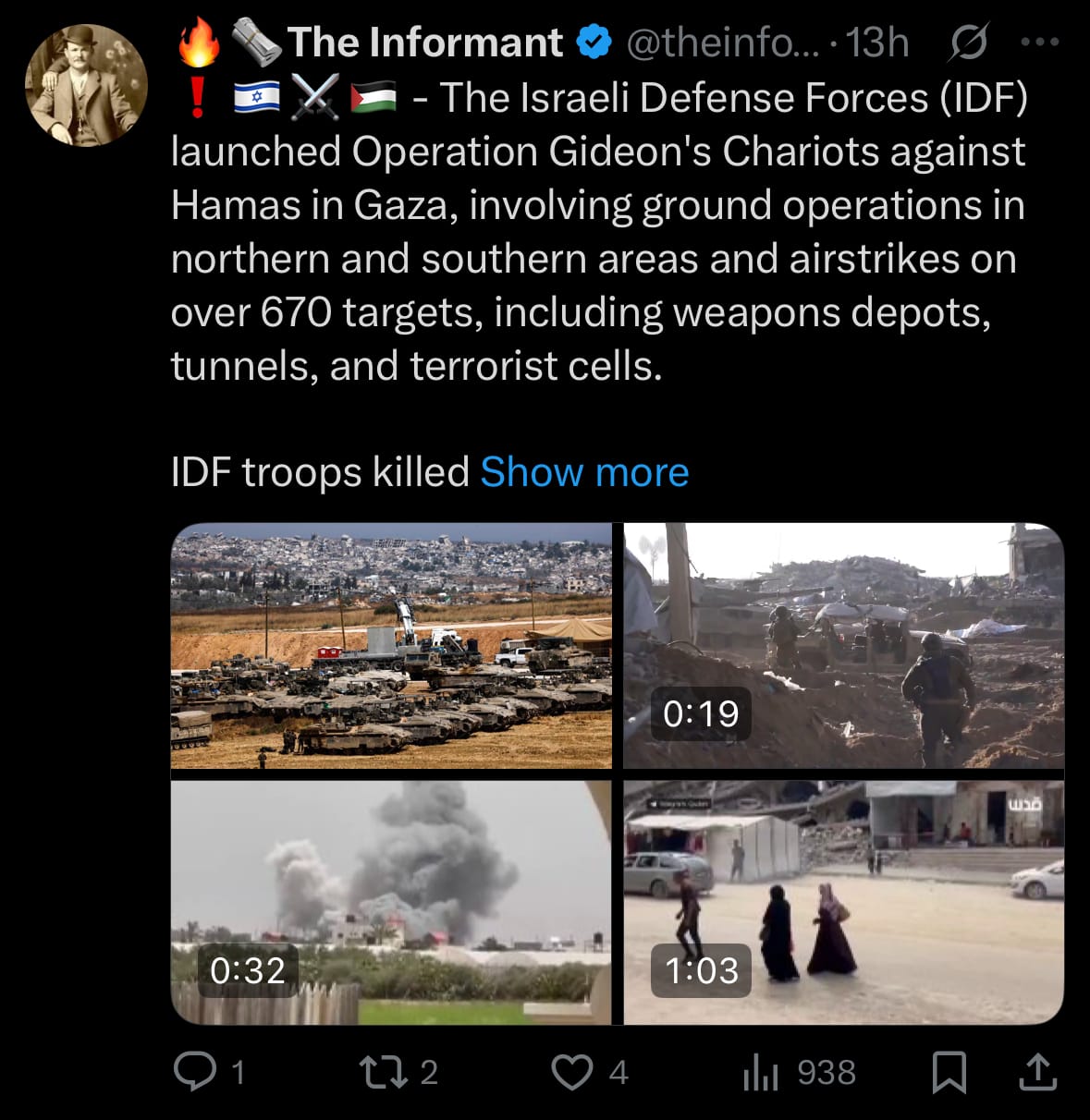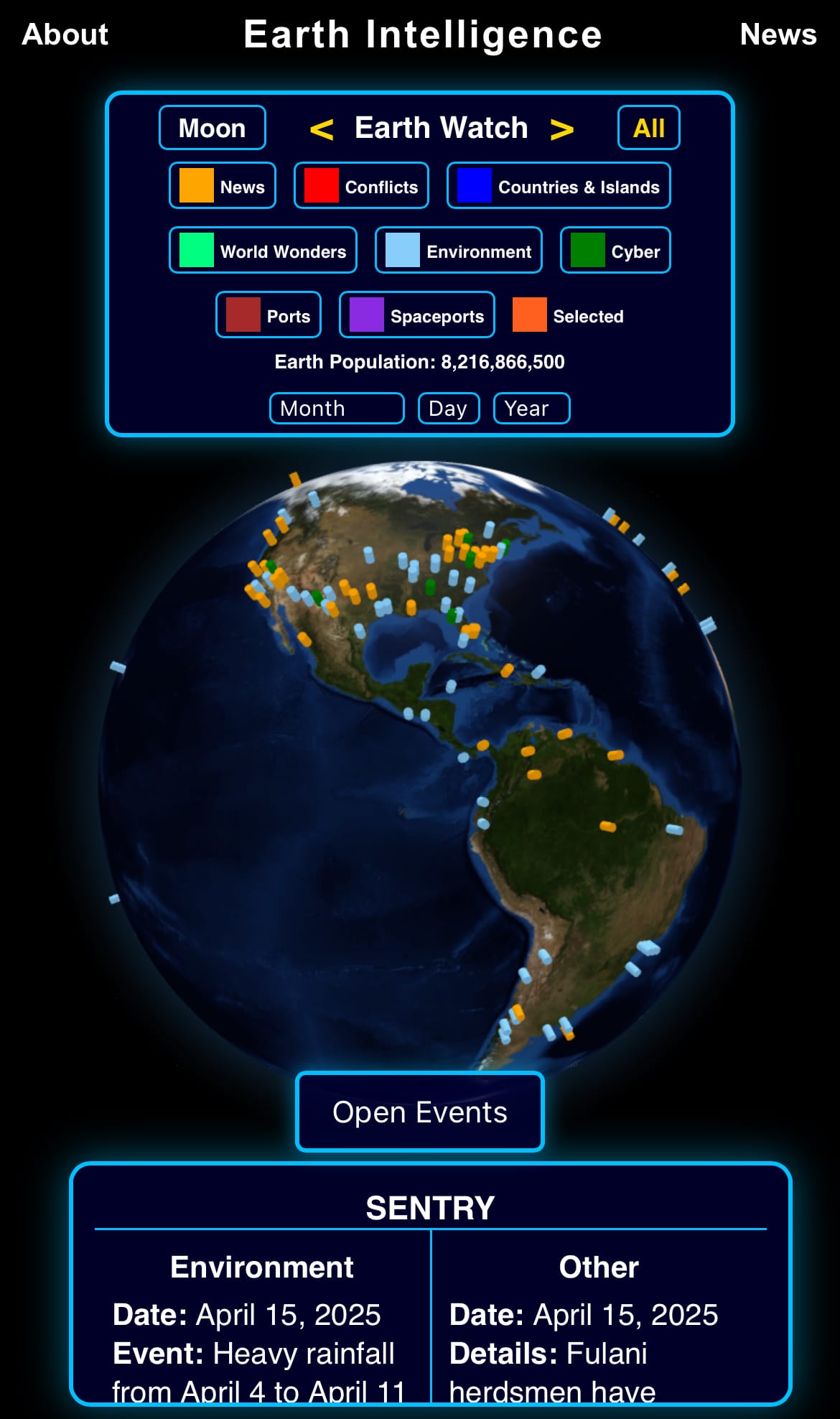Monday☕️

Weekend Recap:
- Over the past 48 hours, from May 17 to early May 19, 2025, a severe weather outbreak has produced multiple tornadoes across the Central Plains, including Kansas, Oklahoma, and Texas, with additional impacts in Missouri and Kentucky. A significant tornado hit Plevna, Kansas, on May 18 at 11:30 PM CDT, reported on X as a large wedge tornado with winds possibly exceeding 200 mph. It damaged homes, felled trees, and caused power outages, though many residents found safety in a church basement. The National Weather Service recorded 28 tornado reports on May 17, alongside hundreds of wind and hail reports, with nine tornadoes confirmed from May 16–17. The storms have resulted in at least 30 fatalities, including 21 in Kentucky and five in St. Louis, Missouri, where an EF3 tornado caused extensive damage.
- The outbreak, fueled by unstable spring weather, triggered tornado watches across Kansas, Oklahoma, and Texas through late May 18, with warnings for strong tornadoes, large hail, and high winds. In Kentucky, a May 17 tornado event led to 17 deaths in Laurel County and destroyed homes in London. Missouri and southeastern Kentucky reported further losses, with significant structural damage in St. Louis. The National Weather Service is assessing the full scope of the destruction, while meteorologists warn of continued severe weather risks into May 19. Authorities are urging residents to remain vigilant as the storm system progresses eastward.
Economics & Markets:
- Today’s commodity market:

- Today’s crypto market:

Geopolitics & Military Activity:
- On May 18, 2025, the Israeli Defense Forces (IDF) launched Operation Gideon’s Chariots in Gaza, targeting Hamas with ground operations in northern and southern areas and airstrikes on over 670 sites, including weapons storage, tunnels, and militant positions. Five IDF divisions are involved, expanding control and moving civilians to designated safer zones. The operation has destroyed infrastructure, such as a 2-km tunnel, and resulted in dozens of reported Hamas militant deaths. Palestinian sources report over 100 fatalities, including civilians, with northern Gaza hospitals closing due to the conflict.

- Amid international calls, including U.S. requests for humanitarian aid, Israel approved aid deliveries to Gaza to address potential hunger issues.
Environment & Weather:
- Today, May 19, 2025, Ghana is experiencing severe flooding in Accra and Kumasi due to heavy rainfall on May 18. A nearly three-hour downpour flooded areas such as Nsawam Highway, Weija, Kaneshie, East Legon Hills, Spintex, and Ashaley Botwe, disrupting traffic and inundating homes. Emergency services, including the Ghana National Fire Service, are assisting affected residents, with reports of individuals trapped in floodwaters in Ashiyie Fulani. Authorities have advised avoiding major roads like the Accra-Kasoa highway, but the situation remains challenging, with drainage systems overwhelmed in many urban areas.

- The flooding highlights ongoing infrastructure challenges, as inadequate drainage and urban planning contribute to recurring floods. The government has promised action, including President Mahama’s recent commitment to address Accra’s flood issues, but progress is limited. The Environmental Protection Authority warns of further flooding risks during the rainy season. Significant investment is needed to improve infrastructure, though estimates suggest costs could reach billions. Emergency response efforts continue as Ghana navigates this latest crisis.

Space:
- Today, May 19, 2025, at 3:38 AM EDT, Galactic Energy’s Ceres 1S rocket launched from a mobile sea platform in China’s coastal waters near Shandong Province. This small-lift rocket carried an unknown payload, possibly four Tianqi IoT satellites, as hinted by X posts. The sea-based launch showcases China’s expanding commercial space sector and the operational flexibility of mobile platforms for deploying small satellites efficiently.
- On May 17, 2025, at 8:29 PM EDT, ISRO’s PSLV-XL rocket lifted off from Satish Dhawan Space Centre in India, carrying the EOS-09 Earth observation satellite. The mission, ISRO’s 101st PSLV launch, ended in failure—the first in eight years—resulting in the loss of the satellite meant for a polar orbit. This rare setback may trigger investigations and could impact India’s future launch plans.
- Earlier on May 17, 2025, at 4:17 AM EDT, Rocket Lab launched its Electron rocket, named “The Sea God Sees,” from Māhia Peninsula, New Zealand. Equipped with the Curie kick stage, it delivered a small satellite to precise orbits for Earth imagery, though specific payload details are unavailable.
- At 12:12 AM EDT on May 17, 2025, Landspace’s ZhuQue-2E rocket launched from Jiuquan Satellite Launch Center, China, successfully deploying six Earth observation satellites.
Statistic:
- Countries ranked by total market capitalization of their public companies:
- 🇺🇸 United States: $60.900T
- 🇨🇳 China: $7.777T
- 🇯🇵 Japan: $5.378T
- 🇮🇳 India: $4.394T
- 🇬🇧 United Kingdom: $3.824T
- 🇨🇦 Canada: $3.180T
- 🇫🇷 France: $3.138T
- 🇩🇪 Germany: $2.827T
- 🇨🇭 Switzerland: $2.572T
- 🇸🇦 Saudi Arabia: $2.532T
- 🇹🇼 Taiwan: $1.904T
- 🇦🇺 Australia: $1.673T
- 🇳🇱 Netherlands: $1.395T
- 🇸🇪 Sweden: $1.182T
- 🇰🇷 South Korea: $1.061T
- 🇮🇪 Ireland: $1.058T
- 🇪🇸 Spain: $1.034T
- 🇦🇪 United Arab Emirates: $1.034T
- 🇮🇹 Italy: $1.008T
- 🇭🇰 Hong Kong: $970.86B
- 🇧🇷 Brazil: $785.87B
- 🇩🇰 Denmark: $664.16B
- 🇸🇬 Singapore: $592.84B
- 🇲🇽 Mexico: $540.80B
- 🇷🇺 Russia: $404.33B
- 🇮🇱 Israel: $403.76B
- 🇮🇩 Indonesia: $395.23B
- 🇧🇪 Belgium: $364.16B
- 🇹🇭 Thailand: $351.96B
- 🇳🇴 Norway: $325.81B
History:
- Tornadoes, violent rotating columns of air, have been documented for centuries, with early records often tied to folklore and anecdotal accounts. In ancient times, cultures described destructive whirlwinds, but systematic study began in the 19th century. The United States, particularly the Midwest’s “Tornado Alley,” became a focal point due to frequent occurrences. By the 1880s, scientists like John Park Finley pioneered tornado research, collecting data and attempting forecasts. The 20th century saw advancements with the establishment of the U.S. Weather Bureau (now the National Weather Service) in 1890, which began formal record-keeping. The Fujita Scale, introduced in 1971 by Tetsuya Fujita, standardized tornado intensity measurements, categorizing them from F0 to F5 based on wind speed and damage. Historical records, though incomplete before modern meteorology, suggest notable events like the 1925 Tri-State Tornado, which killed 695 people, remain among the deadliest.
- Tornado research and monitoring transformed with technology. The advent of Doppler radar in the 1980s revolutionized detection, allowing real-time tracking of storm rotation. The National Tornado Database, maintained by the NOAA’s Storm Prediction Center, now catalogs U.S. tornadoes since 1950, with over 70,000 events recorded by 2025. Research programs like VORTEX (1994–present) have deployed mobile radars and storm-chasing teams to study tornado formation, improving predictive models. Global records, however, remains limited, with only about 1–2% of tornadoes worldwide occurring outside the U.S., mostly in regions like Canada, India, and Argentina. Despite progress, forecasting remains challenging; lead times for warnings average 13 minutes. Ongoing efforts focus on refining models and integrating AI to enhance accuracy, driven by the need to mitigate annual U.S. losses averaging 80 deaths and $10 billion in damages.
Image of the day:

Thanks for reading!
Earth is complicated, we make it simple.
Click image to view the Earth Intelligence System:



Support/Suggestions Email:
earthintelligence@earthintel.news




